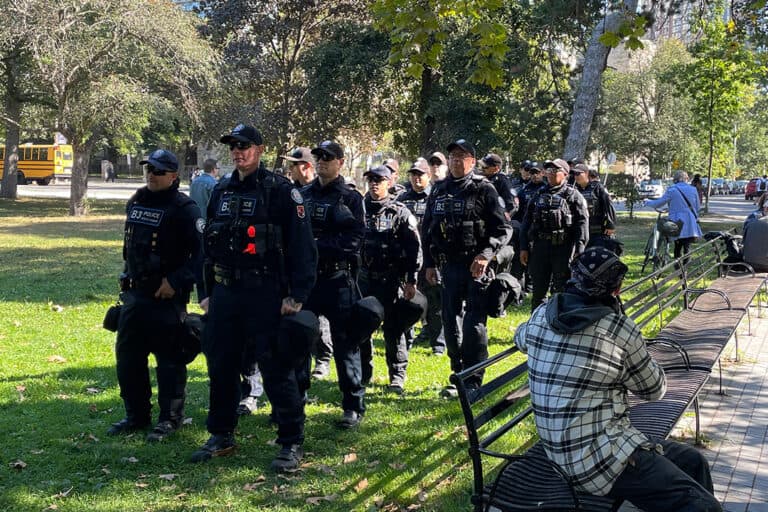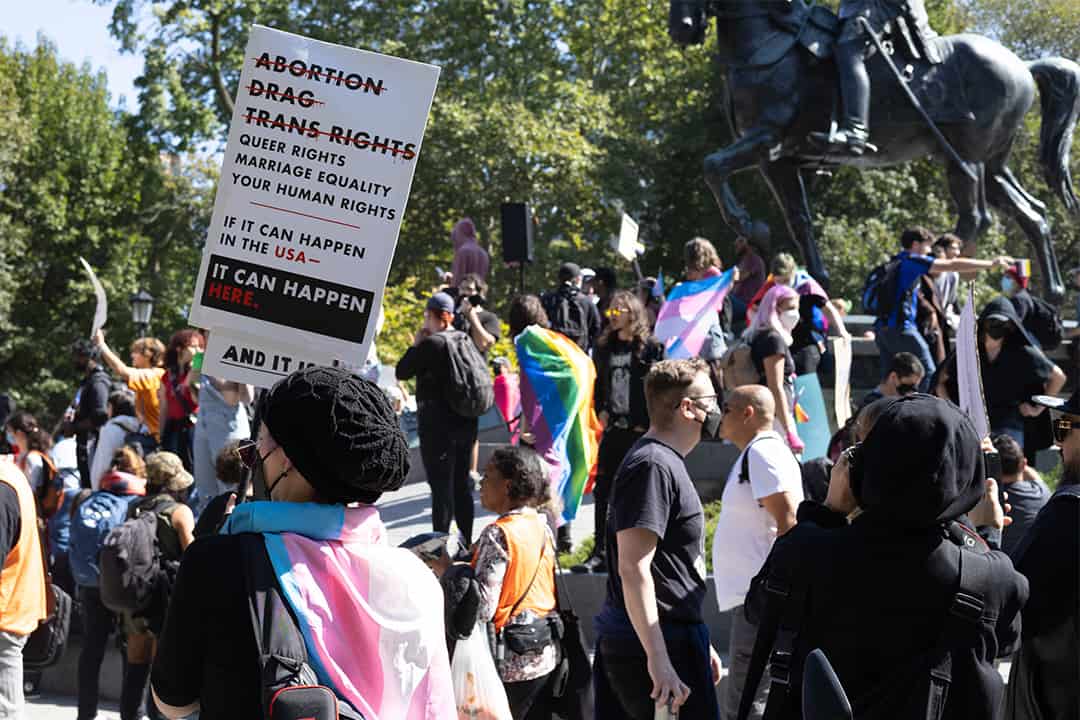Content warning: This article discusses homophobia, transphobia, and harmful homophobic stereotypes, and mentions anti-2SLGBTQ+ violence.
On September 20, a demonstration organized by anti-2SLGBTQ+ organizations, rallying under the title “1 Million March 4 Children,” took place in Queen’s Park. In response, U of T and Toronto-based organizations ran counterprotests and organized other supports for community members.
Groups that took part in the counterprotests included The 519 — an agency providing education and community-building programs to 2SLGBTQ+ Torontonians — and labour organizations such as the Toronto and York Region (TYR) Labour Council and the Ontario Federation of Labour. The city-wide group Students for Queer Liberation Toronto and the U of T-based Prevention, Empowerment, Advocacy, Response, for Survivors (PEARS) Project organized a safe walk program for students worried about harassment from protestors.
The protest on the north side of Queen’s Park
Anti-2SLGBTQ+ demonstrators began gathering at the north side of Queen’s Park at around 9:00 am. One of the main groups of counterprotesters, primarily organized by The 519, headed out from The 519 building at 8:30 am.
In an email to The Varsity, Curran Stikuts, the Director of Advocacy and Strategic Communications at The 519, wrote that the group held the counterprotest to show that most Ontarians “support creating safe and affirming schools for all students, including trans and 2SLGBTQ+ students, and to demonstrate that moves to peel away the hard-fought rights of 2SLGBTQ+ people will not go unchallenged.” He also wrote that more than 2,500 people attended the counterprotest, according to police estimates.
Some counterprotesters who identified themselves to The Varsity as U of T students had joined the counterprotest in small groups. Two of them said they were skipping classes to attend.
When asked about the counterprotester turnout, Erin Ralph — a third-year U of T student studying English and history — said “It’s really nice to see, so beautiful.”
As the day continued, members of the anti-2SLGBTQ+ demonstration stood atop the King Edward VII statue in the middle of the park with a microphone, leading anti-LGBTQ+ chants. The counterprotestors responded, chanting, “Protect trans kids.”
Around 12:00 pm, as more demonstrators joined the crowd, the line between the protest and counter-protests began to blur. At around 1:00 pm, both protests at Queen’s Park began to dissipate, with the demonstrators later heading east down Bloor Street while a few counter-protesters remained at Queen’s Park.
Police presence
The Toronto Police Service (TPS) retained a presence at Queen’s Park, with four large police buses parked on Wellesley Street west, and had blocked off a large section of the street by 11:00 am. At Queen’s Park Circle, police blocked anti-LGBTQ+ demonstrators from counterprotesters by aligning their bikes in a perimeter circle. Demonstrators originally dominated the middle of the circle while counterprotesters surrounded them, and police officers stationed around the circle of bikes limited interaction between the two groups.

Stikuts told The Varsity that The 519 contacted the TPS about the counterprotest so the TPS could assist with street closures and other logistics.
The TPS confirmed to The Varsity that it made one arrest during the protests, charging the person with possession of a weapon and carrying a weapon while attending a public meeting.
Counterprotests on the south side of Queen’s Park
On the south side of Queen’s Park, in front of the Ontario Legislative Building, the TYR Labour Council, which represents 220,000 workers and their families across various sectors, and Community Solidarity Toronto, a progressive coalition focused on labour issues and racial and climate justice, co-hosted a counterprotest starting at 8:30 am.
Members of the United Steel Workers Local 1998, a union representing more than 10,000 administrative and technical staff across U of T’s three campuses, attended the counterprotest. “We have a growing number of USW members and USW family members who are 2SLGBTQIA+-identified, so we want to underscore that this is a workers’ issue. We cannot allow hate groups to divide us,” the group wrote on its Instagram page.
Background on the anti-2SLGBTQ+ demonstration
According to the 1 Million March 4 Children website, the demonstrations held across Canada on Wednesday advocated for the elimination of 2SLGBTQ+-inclusive curricula and support measures for 2SLGBTQ+ students in schools.
Although the groups organizing the protests claim their movement is “inclusive and diverse,” the Canadian Anti-Hate Network characterizes their goals as “unequivocally exclusionary.” At other protests around the country, news outlets documented explicit anti-LGBTQ+ hate speech, with Ottawa police arresting three people for incitement of hatred.
Multiple organizations supporting the march have a history of engaging in anti-2SLGBTQ+ hate speech, and have specifically perpetuated a conspiracy conflating 2SLGBTQ+ identities with pedophilia. A 2023 report from the US-based LGBTQ+ advocacy group Gay and Lesbian Alliance Against Defamation and the Anti-Defemation League tracking harassment, vandalism, and assault motivated by anti-LGBTQ+ hate from June 2022 to April 2023 found that the majority of hate incidents it documented made explicit references to the pedophilia conspiracy theory.
Attendees of the September 20 Toronto anti-2SLGBTQ+ demonstration included both families and individuals. Some children held signs that read, “I belong to my parents.”
The Canadian context
In an interview with The Varsity, Anglican Reverend Maggie Helwig, an alumna of the Toronto School of Theology, said that, although the anti-2SLGBTQ+ demonstrators currently represent a minority opinion, she worries about their views entering the mainstream. In an email to The Varsity, she noted the provincial government’s role in stoking transphobia and the view that schools push “some kind of coercive ‘gender ideology.’ ”
In early September, Doug Ford spoke at an event, telling attendees that schools should have to inform parents if their children used a different name or pronouns while at school, and perpetuated a view that school boards “indoctrinate” children by implementing 2SLGBTQ+-inclusive curricula. The provincial governments of Saskatchewan and New Brunswick also recently implemented policies requiring parental consent for teachers to use names and pronouns for students other than those assigned at birth.
In response to Ford’s comments, the Ontario Secondary School Teachers Federation released a statement arguing that limiting students’ ability to choose how they express their gender and self-identify can harm their sense of self-worth and lead to negative mental health outcomes.
Human rights groups have also criticized these policies, arguing that they will lead teachers to out transgender kids into transphobic parents. Stikuts wrote that he hopes people will recognize that these policies “cause real harms to 2SLGBTQ+ students and youth.”
The Rev’d Canon Andrea Budgey — who serves as the Humphrys Chaplain to Trinity College — also attended the counterprotest. In an email to The Varsity, Budgey wrote that she believes many people who oppose 2SLGBTQ+ rights don’t understand what they’re protesting against in schools. “I’m sure there were people in yesterday’s demonstration who actually believed the horrible misrepresentations the organisers put out, who could be brought to better understanding if the issues were unpacked in a more nuanced way,” she added.
Helwig said that she hopes that trans children with people in their lives who do not accept them “will see that there are a whole lot of us out here who are with them.”
Supports for students
In light of the demonstration happening close to the St. George campus, the PEARS Project — a grassroots U of T group supporting survivors of gender-based violence — and Students for Queer Liberation Toronto hosted a student-run safe walk program from 9:00 am onwards. Students who had class and wanted someone to walk with them could contact PEARS to access volunteers, who were predominantly 2SLGBTQ+ or otherwise marginalized, according to a PEARS spokesperson.
In a statement to The Varsity, the PEARS spokesperson wrote that around 15 to 20 students used the program, and “many” students told PEARS that they didn’t want to leave their homes without someone else.
“Queer and trans students, particularly racialized and disabled queer and trans students were the ones primarily on the front lines of the counter-protest, showing yet again how WE keep us safe,” wrote the spokesperson.
On September 19, Kelly Hannah-Moffat — U of T’s vice-president, people strategy, equity, and culture — released a statement noting that U of T had consulted with community partners about the planned demonstration. “In the wake of the recent violent incident targeting women and gender studies at a peer university, we understand that certain members of our own community may feel particularly impacted,” reads the statement, referring to a stabbing that occurred at a University of Waterloo gender studies class in June.
Moffat also reaffirmed the university’s support for 2SLGBTQ+ people at the university and worldwide and highlighted support through the Sexual and Gender Diversity Office and the university’s other equity offices, which exist on all three campuses.
The University of Toronto Students’ Union also released a statement that condemned the protests and directed students to various safety resources.
The Varsity reached out to the provincial government, which did not provide comment in time for publication.
With files from Caroline Bellamy and Sarah Artemia Kronenfeld.



No comments to display.